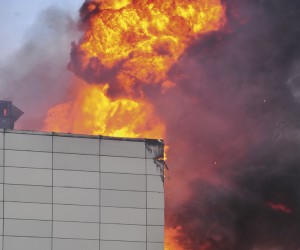Many companies have extensive fire safety systems that are not adequately maintained. To ensure that critical apparatus such as water pumps and firefighting equipment like hydrants and extinguishers are kept in working order, it needs to be monitored, inspected and maintained on a regular basis. Verifi aids the owner, manager, inspector and technician in keeping track of the current readiness of firefighting equipment.
The Sperosens Verifi system provides an encompassing, accurate, always-available status of various critical systems such as fire protection equipment.It monitors and reports the real-time status and fault conditions of vital equipment to users according to pre-set, customer defined parameters. The system keeps a log and reports on inspection and auditing data such as maintenance of fire extinguishers and hose reels. Customers can now be proactive by utilising reports on location, status and maintenance planning for such equipment.In accordance with SANS requirements, the user can obtain electronic records of inspections and events. Real-time computer displays present a detailed overview of the entire facility including geospatial graphing, event logging, alarming, historic trends and reports. The Verifi system provides the user with peace of mind that the initial, massive investment in fire protection and other critical systems is preserved. Early warning is given to report faulty equipment and overdue inspections to prevent loss of property, loss of life, and loss of income.Verifi measures parameters remotely and communicates the data to the cloud using Internet of Things (IoT) communication technology. Two options are available for the monitoring of equipment. The customer can perform monitoring in-house, or Sperosens can supply the service of monitoring and reporting on behalf of the customer. In the latter instance, pre-selected responsible employees will receive regular exception reports and critical alarms.
Fire fighting equipment such as a hose reels or fire extinguishers are fitted with NFC tags that map to management information such as asset type, site, area, serial number and service interval. When equipment is serviced by using a Smartphone with the Verifi Application installed, the technician is prompted to perform a list of checks relevant to the type of equipment and in accordance with SANS servicing requirements.Other equipment such as fire panels, fire water pressure and flow, emergency pumps, fire door status, smoke and temperature are monitored with appropriate multi-purpose sensors and values are measured and transmitted by a combination of scheduled transmissions and event triggers.In order for the system to monitor real-time values within a system, Verifi makes use of state-of-the-art IoT technology. This technology enables Verifi to monitor sensors that have been remotely deployed as far as 8 kilometers away (without any line-of-sight requirements), and without the need for a SIM-card or pre-registration. Remote devices can be configured to run on battery power, and can have a lifespan of up to 2 years.
Critical Real-Time Monitoring
The flexibility and scalability of the Verifi system does not, however, stop at fire safety equipment. Some aspects of a system require real-time monitoring. Consider, for instance, a scenario where the temperature of a warehouse fridge is crucial to business continuity. It is important that the maintenance and operational status of the asset be monitored on a frequent basis. The site manager needs to know immediately when the critical system are failing or are about to fail. Verifi has a built-in, real-time monitoring engine, developed with rock-solid Adroit SCADA technology, and almost anything that can be measured can be reported on.
System Visibility
One of the core features of a SCADA system is to view the status of the system graphically. It makes use of graphical views such as maps and floor plans in order to gain a high-level view of system status. In the example below, the system status is critical (all sensors are red). The operator can hover over the icons in order to obtain more information.
Alarms
Alarms form another critical part of the system. As soon as a tag’s alarm conditions are met, an alarm pop-up will be shown with more information. The alarm overview list will show a list of all alarms in the system, sorted by severity. Reporting forms part of the backbone of any data-critical system. The system makes use of Microsoft SQL Reporting Services in order to deliver real-time reports that offer critical insights. Reports can be tailor made based on user requirements.
Non-Critical Maintenance
Some aspects of a system do not require real-time monitoring. In these instances, fault conditions are handled off-line, and system criticality is not impacted. If we consider for example a fire extinguisher that needs to be serviced annually, we will realise that although important, it is not critical that an alarm be raised the instant a service is due. In this event, it will be appropriate to email the site manager a list of assets that require attention, or that need to be serviced in the immediate future.
There is no limit on the amount or complexity of processes that Verifi/FlowCentric can monitor.






